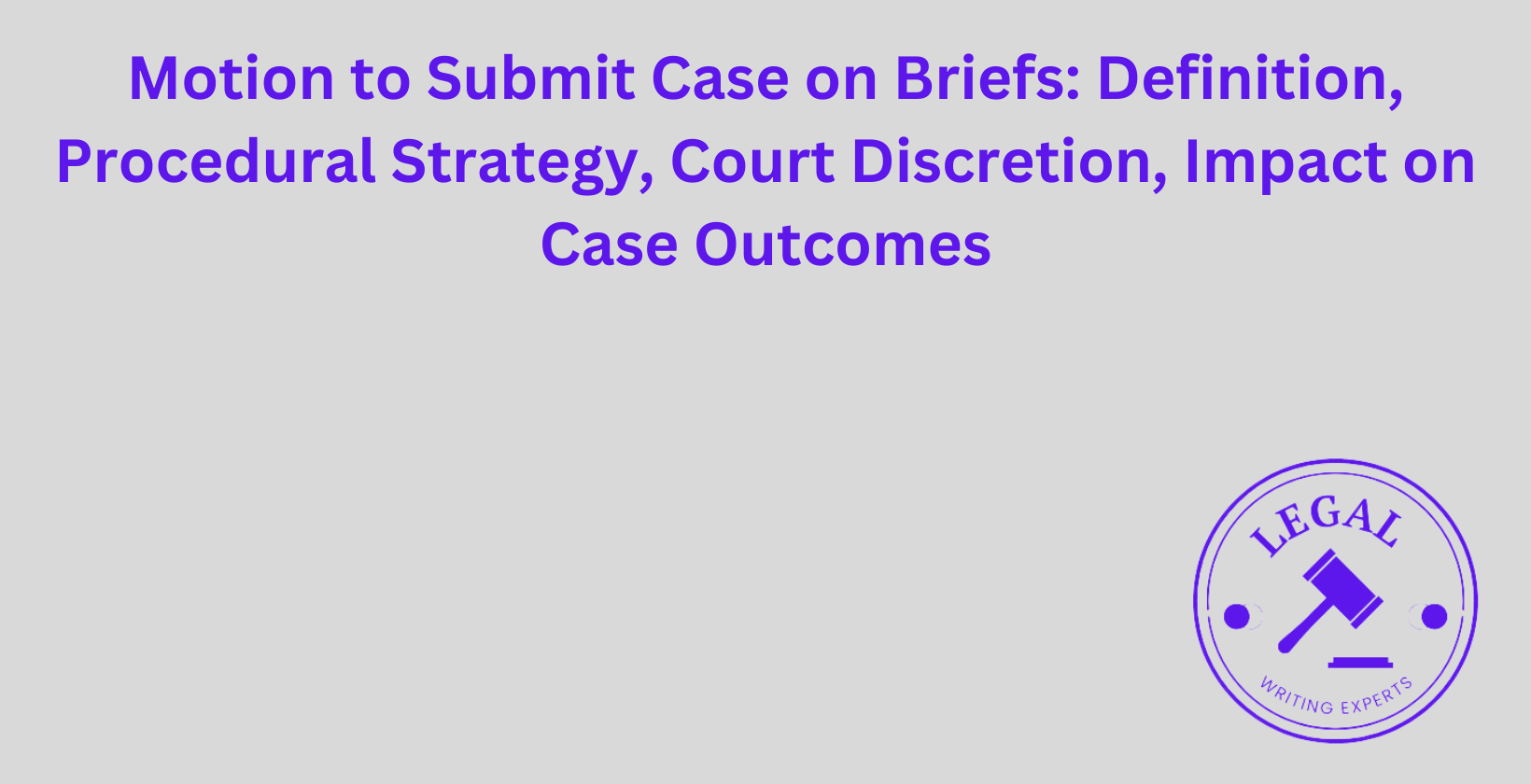Motion to Submit Case on Briefs
Written by
Jessica E
October 7, 2024 · 8 min read

A motion to submit a case on briefs is a legal procedure where parties request the court to decide a case based solely on written arguments without oral arguments. This article explores the definition, process, strategic considerations, and impact of submitting cases on briefs. It covers how to write and file such motions, where to hire legal writers, procedural requirements, court discretion, and the effects on case outcomes. The article provides guidance on when to request submission on briefs, potential consequences, relevant case examples, and the role of court rules in this process.
What Is a Motion to Submit a Case on Briefs?
A motion to submit a case on briefs is a formal request to the court asking to decide a case based solely on written arguments without oral presentations. This legal procedure allows parties to present their arguments in writing, typically through legal briefs, and waive their right to oral arguments before the court. The court then reviews the submitted briefs and makes a decision based on the written materials provided by the parties.
How to Write a Motion to Submit a Case on Briefs?
To write a motion to submit a case on briefs, begin with a clear statement of the request and the legal basis for it. Include a concise summary of the case, explain why submission on briefs is appropriate, and cite relevant court rules or precedents. Outline the key arguments presented in the briefs and emphasize how they adequately address the issues at hand. Conclude with a formal request for the court to decide the case based on the submitted briefs. Ensure the motion is well-organized, concise, and follows the court’s formatting requirements.
Where to Hire a Legal Writer to Draft a Motion to Submit a Case on Briefs?
Legal writers can be hired through Legal Writing Experts channel to draft a motion to submit a case on briefs. Legal Writing Experts is an online platform that offers access to freelance legal writers with expertise in drafting legal documents. We often have in-house legal writers or connections to freelance professionals. We also provide document drafting assistance and offer resources for finding qualified writers.
How to File a Motion to Submit a Case on Briefs?
Filing a motion to submit a case on briefs involves several steps. First, prepare the motion document according to court rules and formatting guidelines. Include all necessary information and arguments supporting the request for submission on briefs. Next, file the motion with the court clerk, either in person or electronically, depending on the court’s filing system. Pay any required filing fees. Serve copies of the motion to all parties involved in the case, following proper service procedures. File a proof of service with the court to confirm that all parties have been notified. Wait for the court’s decision on the motion, which may come in the form of an order granting or denying the request to submit the case on briefs.
What Are the Strategic Considerations for Submitting a Case on Briefs?
Strategic considerations for submitting a case on briefs include assessing the strength of written arguments compared to potential oral presentations. Cases with complex legal issues that are better explained in writing may benefit from submission on briefs. Consider the court’s familiarity with the subject matter and whether additional oral clarification would be helpful. Evaluate the potential cost savings of avoiding oral arguments. Assess the likelihood of unfavorable questioning during oral arguments that could weaken your position. Consider the opposing party’s strengths in oral advocacy and whether submission on briefs might neutralize this advantage. Weigh the impact on appeal timelines and the potential for expedited decision-making through submission on briefs.
What Are the Procedural Requirements for Filing a Motion to Submit on Briefs?
The procedural requirements for filing a motion to submit on briefs typically include adhering to court rules regarding motion format and content. The motion must be filed within the timeframe specified by court rules, often before the deadline for requesting oral arguments. It should clearly state the request for submission on briefs and provide justification for this approach. All parties must be properly served with the motion. Some courts may require consent from all parties or a statement of their positions on the motion. The motion should be accompanied by any supporting documents or exhibits referenced in the argument. Compliance with local court rules regarding electronic filing or paper submission is essential. Some jurisdictions may require a proposed order for the court to sign if the motion is granted.
How Do Courts Exercise Discretion in Motions to Submit a Case on Briefs?
Courts exercise discretion in motions to submit a case on briefs by considering several factors. They evaluate the complexity of the legal issues involved and whether written arguments sufficiently address these issues. Courts assess the potential benefit of oral arguments in clarifying points of law or fact. The court’s familiarity with the subject matter may influence its decision to grant or deny the motion. The preferences of individual judges or the court’s general practices regarding oral arguments play a role. Courts consider the potential impact on judicial efficiency and case management. The positions of all parties involved in the case are taken into account. In some instances, courts may grant partial submission on briefs, allowing limited oral arguments on specific issues.
What Is the Impact of Submitting a Case on Briefs on Case Outcomes?
Submitting a case on briefs can have significant impacts on case outcomes. Cases decided on briefs may receive more focused attention to written arguments, potentially benefiting parties with strong written presentations. The absence of oral arguments eliminates the opportunity to clarify points or respond to judges’ questions in real-time, which could affect the court’s understanding of complex issues. Submission on briefs may lead to faster decisions, as courts can review materials at their convenience without scheduling oral arguments. The outcome may be influenced by the quality and persuasiveness of the written briefs, placing greater emphasis on legal research and writing skills. In some cases, submission on briefs might result in more predictable outcomes, as judges rely solely on the written record without the variability introduced by oral advocacy.
When Is It Best to Request Submission on Briefs Instead of Oral Argument?
Requesting submission on briefs is best when the case involves primarily legal issues that can be fully addressed in writing. It’s advantageous when the facts are undisputed and the legal arguments are clear and well-developed in the briefs. Cases with extensive documentary evidence that can be thoroughly examined in written form are suitable for submission on briefs. When the potential for unfavorable questioning during oral arguments outweighs the benefits, submitting on briefs may be preferable. If there are time constraints or the need for an expedited decision, submission on briefs can be beneficial. Cases where the costs of oral arguments would be prohibitive for the client may warrant submission on briefs. When the opposing party has particularly strong oral advocacy skills, neutralizing this advantage through written submissions might be strategic.
What Are the Consequences of Failing to Secure Approval for Submission on Briefs?
Failing to secure approval for submission on briefs can lead to several consequences. The case will proceed to oral arguments as originally scheduled, requiring parties to prepare for and participate in court presentations. This may result in additional time and financial costs for clients. Parties who were unprepared for oral arguments due to anticipating approval of their motion may be at a disadvantage. The court may view the failed motion as a strategic misstep, potentially affecting its perception of the party’s case management. In some instances, failing to secure approval might delay the resolution of the case if parties are not immediately ready for oral arguments. The opportunity to focus the court’s attention solely on written arguments is lost, potentially impacting how the case is perceived and decided.
What Case Examples Involve Submission on Briefs?
Case examples involving submission on briefs often include appellate cases where legal issues are well-defined and factual disputes are minimal. For instance, in “Smith v. Jones” (2019), the Supreme Court of State X granted a motion to submit on briefs in a complex tax law interpretation case, citing the extensive written arguments as sufficient for decision-making. In “Corporation A v. Corporation B” (2020), a federal appeals court decided a patent infringement case on briefs, noting that the technical nature of the dispute was best addressed through detailed written analysis. The “City of Metropolis v. Environmental Group” (2021) case was submitted on briefs in a state appellate court, as both parties agreed that the statutory interpretation issues were comprehensively covered in their written submissions.
What Is the Role of Court Rules in Submitting a Case on Briefs?
Court rules play a crucial role in submitting a case on briefs. They establish the procedural framework for filing motions to submit on briefs, including deadlines, format requirements, and necessary content. Court rules often specify the circumstances under which submission on briefs is permissible or encouraged. They may outline the factors courts consider when deciding whether to grant such motions. Some court rules require parties to seek consent from opposing counsel before filing a motion to submit on briefs. Rules can dictate the page or word limits for briefs submitted in lieu of oral arguments. They may also provide guidance on how to request partial submission on briefs for specific issues while maintaining oral arguments for others. Understanding and adhering to these rules is essential for successfully navigating the process of submitting a case on briefs.
How to Oppose a Motion to Submit a Case on Briefs?
To oppose a motion to submit a case on briefs, begin by filing a written opposition with the court. Clearly state the reasons for opposing the motion, such as the complexity of the case requiring oral clarification or the presence of factual disputes best addressed through questioning. Highlight any legal precedents or court rules that support the need for oral arguments. Emphasize the potential benefits of oral presentation in aiding the court’s understanding of the issues. Address any specific points raised in the motion to submit on briefs and explain why they are insufficient. If applicable, discuss how oral arguments could lead to a more just or efficient resolution of the case. Ensure the opposition is filed within the timeframe specified by court rules and properly served to all parties involved.
How Does Submitting a Case on Briefs Affect Appeal Timelines?
Submitting a case on briefs can significantly affect appeal timelines. The process often expedites the decision-making process as courts can review briefs at their convenience without scheduling oral arguments. This can lead to faster resolutions of appeals. The elimination of oral argument preparation time can shorten the overall appeal process. However, if a motion to submit on briefs is denied close to the scheduled oral argument date, it might cause delays if parties need additional time to prepare. Some courts have specific timelines for decisions on cases submitted on briefs, potentially providing more predictable resolution dates. The appeal timeline may be influenced by the court’s caseload and how quickly it can process cases submitted on briefs compared to those requiring oral arguments.
Meet the Author
Distinguished linguist at Legal Writing Experts
Jessica is an expert legal writer with a remarkable blend of legal knowledge and linguistic precision. She earned her Juris Doctor degree from Duke University, where she attended on a prestigious Law Faculty Merit Scholarship. At Duke, Jessica demonstrated her exceptional abilities by serving as an editor of the Duke Law Review.
After graduating, Jessica further refined her skills during a two-year appellate clerkship at a distinguished law firm in North Carolina. Throughout law school, she enhanced her research and writing expertise as a research assistant and writer for various legal firms. Jessica’s deep understanding of legal language and meticulous attention to detail make her an invaluable asset to our legal writing services.


